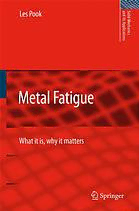
Metal fatigue : what it is, why it matters PDF
Preview Metal fatigue : what it is, why it matters
METALFATIGUE SOLID MECHANICS AND ITS APPLICATIONS Volume 145 Series Editor: G.M.L. GLADWELL Department of Civil Engineering University of Waterloo Waterloo, Ontario, Canada N2L3GI Aims and Scope of the Series The fundamental questions arising in mechanics are: Why?, How?, andHow much? The aim of this series is to provide lucid accounts written by authoritative researchers giving vision and insight in answering these questions on the subject of mechanics as it relates to solids. The scope of the series covers the entire spectrum of solid mechanics. Thus it includes the foundation of mechanics; variational formulations; computational mechanics; statics, kinematics and dynamics of rigid and elastic bodies: vibrations of solids and structures; dynamical systems and chaos; the theories of elasticity, plasticity and viscoelasticity; composite materials; rods, beams, shells and membranes; structural control and stability; soils, rocks and geomechanics; fracture; tribology; experimental mechanics; biomechanics and machine design. The median level of presentation is the first year graduate student. Some texts are monographs defining the current state of the field; others are accessible to final year undergraduates; but essentially the emphasis is on readability and clarity. For a list of related mechanics titles, see final pages. Metal Fatigue What It Is, Why It Matters by LESPOOK UniversityCollegeLondon,UK AC.I.P.CataloguerecordforthisbookisavailablefromtheLibraryofCongress. ISBN978-1-4020-5596-6(HB) ISBN978-1-4020-5597-3(e-book) PublishedbySpringer, P.O.Box17,3300AADordrecht,TheNetherlands. www.springer.com Printedonacid-freepaper AllRightsReserved ©2007Springer Nopartofthisworkmaybereproduced,storedinaretrievalsystem,ortransmitted inanyformorbyanymeans,electronic,mechanical,photocopying,microfilming,recording orotherwise,withoutwrittenpermissionfromthePublisher,withtheexception ofanymaterialsuppliedspecificallyforthepurposeofbeingentered andexecutedonacomputersystem,forexclusiveusebythepurchaserofthework. Theauthor’sfirstcar,a1932Riley9Falcon.Itsmanyailmentsincludedmetal fatiguefailuresinagearboxselectorfork,timinggearteeth,ahalfshaft,anda suspension spring. Moderncarsaremuchbetterinthatmetalfatigue failures areveryunusual. Leslie Philip (Les) Pook was born in Middlesex, England in 1935. He ob- tainedaBScinmetallurgyfromtheUniversityofLondonin1956.Hestarted his career at Hawker Siddeley Aviation Ltd, Coventry in 1956. In 1963 he moved to the National Engineering Laboratory, East Kilbride, Glasgow. In 1969, while at the National Engineering Laboratory, he obtained a PhD in mechanical engineering from the University of Strathclyde. Dr Pook moved to University College London in 1998. He retired formally in 1998 but re- mained affiliated to University College London as avisiting professor. Heis a Fellow of the Institution of Mechanical Engineers and a Fellow of the In- stituteofMaterials,MineralsandMining.LesmarriedhiswifeAnnin1960. Theyhaveadaughter, Stephanie, andason,Adrian. Contents Preface...................................................... xiii Notation..................................................... xv 1 Introduction ............................................. 1 2 Historical Background .................................... 7 2.1 Introduction. ......................................... 7 2.2 ExperimentalWork.................................... 8 2.2.1 FatigueTestingofComponentsandStructures ....... 8 2.2.2 FatigueTestingofLaboratorySpecimens ........... 9 2.2.3 Investigation oftheMechanisms ofMetalFatigue .... 10 2.2.4 Investigation ofFatigueCrackPaths................ 10 2.2.5 FatigueCrackPropagation RateTesting............. 11 2.3 TheModernEra ...................................... 12 2.3.1 FractureMechanics.............................. 12 2.3.2 Servohydraulic TestingEquipment ................. 12 2.3.3 InfluenceofComputers .......................... 13 2.3.4 Standardisation ................................. 13 3 ConstantAmplitudeFatigue ............................... 15 3.1 Notation ............................................. 15 3.2 S/N (Wöhler)Curves ................................. 15 3.3 ScatterinFatigueData................................. 20 3.4 MechanismsofMetalFatigue ........................... 24 3.4.1 FatigueCrackInitiation .......................... 25 3.4.2 FatigueCrackPropagation........................ 26 3.4.3 Ratchetting..................................... 30 viii Contents 3.5 EffectofMechanismsonS/N Curves .................... 31 4 VariableAmplitudeandMultiaxialFatigue.................. 35 4.1 Introduction. ......................................... 35 4.2 Mathematical DescriptionofFatigueLoadings............. 37 4.2.1 ConstantAmplitudeFatigueLoadings .............. 39 4.2.2 GaussianRandomLoadings....................... 39 4.2.3 BlockFatigueLoadings .......................... 42 4.3 Miner’sRule ......................................... 44 4.3.1 WeightedAverageStressRange ................... 47 4.3.2 DamageDensityFunctions ....................... 49 4.3.3 CycleCounting ................................. 50 4.4 StandardLoadHistories................................ 53 4.4.1 Applications ofStandardLoadHistories ............ 54 4.4.2 DevelopmentofStandardLoadHistories............ 55 4.5 MultiaxialFatigueinMetals ............................ 59 4.5.1 Multiaxial FatigueTests .......................... 59 4.5.2 Multiaxial FailureCriteria ........................ 62 5 FatigueDesign ........................................... 67 5.1 Introduction. ......................................... 67 5.2 FailureAnalysis ...................................... 68 5.3 Situations, Philosophies andApproaches.................. 69 5.3.1 Situations ...................................... 69 5.3.2 Philosophies.................................... 70 5.3.3 Approaches .................................... 72 5.4 ProductLiability ...................................... 77 5.4.1 TheConsumerProtectionAct ..................... 78 5.4.2 EnforcementAuthorities ......................... 79 5.5 SafetyRegulations .................................... 79 5.5.1 TheGeneralProductSafetyRegulations ............ 80 6 TheUncrackedSituation .................................. 83 6.1 Introduction. ......................................... 83 6.2 EffectofSurfaceFinish ................................ 84 6.3 EffectofMeanStress .................................. 85 6.3.1 EffectofResidualStresses........................ 88 6.4 EffectofMultiaxialFatigueLoading ..................... 88 6.5 EffectofNotches ..................................... 89 6.6 BicycleCrankshaft Analysis ............................ 93 Contents ix 6.7 ScatterunderVariableAmplitudeFatigueLoading ......... 96 6.8 ImprovementofFatigueLife............................ 97 7 TheCrackedSituation .................................... 101 7.1 Introduction. ......................................... 101 7.2 InitialCrackSize ..................................... 102 7.3 FinalCrackSize ...................................... 103 7.4 ConstantAmplitudeFatigueCrackPropagation ............ 105 7.4.1 Determination ofFatigueCrackPropagation Rates ... 106 7.4.2 FactorsAffectingFatigueCrackPropagationRates ... 109 7.4.3 ThresholdforFatigueCrackPropagation............ 116 7.4.4 OverallFatigueCrackPropagation Behaviour........ 117 7.4.5 ShortCracks ................................... 118 7.4.6 FatigueLifeinthePresenceofaCrack ............. 122 7.5 VariableAmplitudeFatigueCrackPropagation ............ 124 7.5.1 WeightedAverageStressRange ................... 124 7.5.2 Interaction Effects............................... 127 7.6 Fractography ......................................... 129 7.6.1 FatigueCrackPropagation inaWeldedJoint ........ 130 8 FatigueCrackPaths ...................................... 135 8.1 Introduction. ......................................... 135 8.1.1 ClassesofFatigueCrackPropagation............... 137 8.2 CrackPathsinTwoDimensions ......................... 138 8.2.1 MixedModeThresholds ......................... 138 8.2.2 CrackPathStability ............................. 142 8.2.3 CrackPathPrediction............................ 148 8.3 PlanarCrackPaths .................................... 151 8.3.1 CrackPathDevelopment ......................... 151 8.3.2 LeakbeforeBreak............................... 154 8.4 CrackPathsinThreeDimensions........................ 155 8.4.1 LowerBoundMixedModeThresholds ............. 157 8.4.2 CrackPathDetermination ........................ 158 9 WhyMetalFatigueMatters ............................... 161 9.1 Introduction. ......................................... 161 9.2 Avoidance ofFatigueFailure............................ 162 9.3 ResearchandDevelopment ............................. 163 9.4 TheRoleofNonDestructiveTesting ..................... 164 9.5 CurrentTrends ....................................... 164
